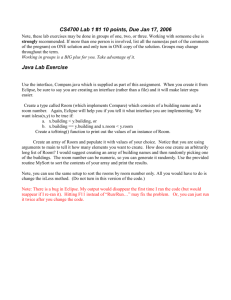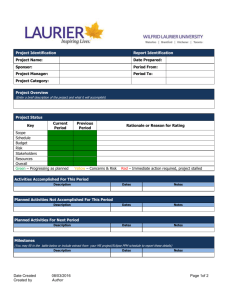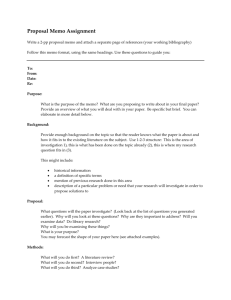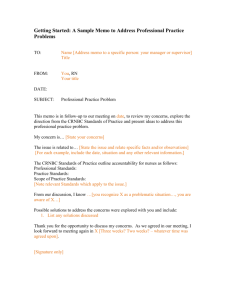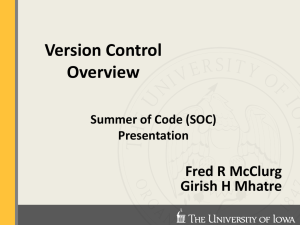Best Practices in Managing Change
advertisement
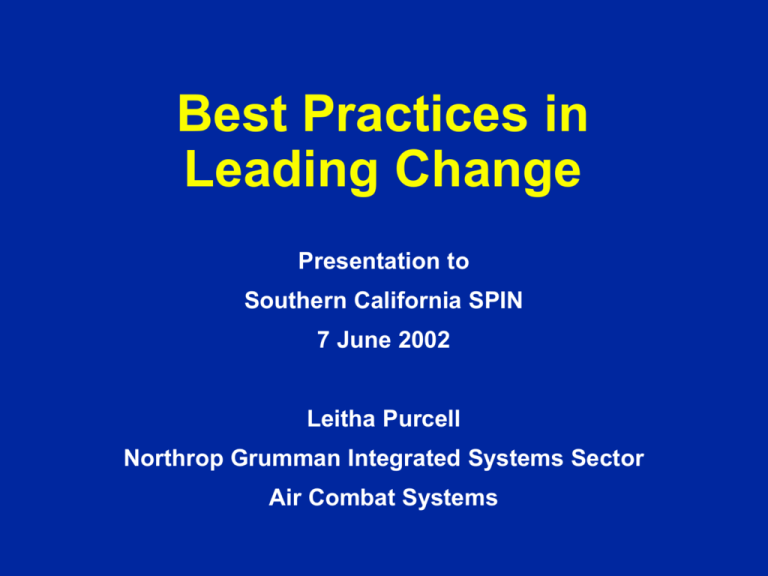
Best Practices in Leading Change Presentation to Southern California SPIN 7 June 2002 Leitha Purcell Northrop Grumman Integrated Systems Sector Air Combat Systems Change To Make Different in Some Particular: ALTER To Make Radically Different: TRANSFORM To Give a Different Position, Course or Direction -- Webster’s Collegiate Dictionary Process Change Is Multi-Dimensional • More Than – Designing a Process – Writing Procedures – Doing Some Training (If You’re Lucky) • Involves People – May Affect Their Day-to-Day Activities – Can Change the Perception of Power – What’s in It for Me? • Requires More Than Bodies, Need the Souls Also Change Can Be Perceived As Positive or Negative – Getting a Job After Graduating From College – Getting Married – Having a Child – Child Leaving for College – Getting a New Computer – Losing a Job – Divorce – Death of a Parent You’ll never get me up on one of those butterfly things! Why Do We Resist Change • Change Is a Feature of the Cosmos – It Is Inevitable • But Human Crave Order and Look for It Everywhere • Human Behavior, in the Aggregate, Defines Culture • Culture Reflects This Need for Order – Shared Meaning, Common Languages, Religious or Secular World-views Help to Make the World Seem Less Unpredictable Than It Really May Be • Therefore, Culture “Damps Down” Change Common Reasons for Resistance • Self-interest • Fear of the Unknown • Conscientious Objection or Differing Perceptions • Suspicion • Conservatism Response to Change Is Highly Individual • Mixture of Emotion and Rationalization • Don’t Assume Others Will Respond the Same or That You Will, Under Different Circumstances Managing Change Requires Looking at All the Dimensions • Past History in Putting Change in Place • Degree of Sponsorship • Authenticity of Sponsorship (Walk the Talk?) • Organizational and Individual Current Stress • Who Will Be Impacted by the Change • Cultural Fit of the Change • Addressing “What’s in It for Me” • Communication of the Change and Its Progress • Skill Sets of the Change Agents Square Wheels Change = Motivation X Vision X Next Steps • Motivation – Some Good Reason to Give up the Status Quo • Vision – A Clear and Practical Vision of the Desired Future State • Next Steps – an Understanding of the Next Steps Required to Progress Toward the Vision • If One Is Missing, Little Change Will Take Place Best Practices/Lessons Learned # 1: Develop a Compelling Vision • How Things Will Be Better With the Change • More Than Sloganeering • Leaders and Change Agents Need Their Own Individual Visions and Need to Know How That Fits Into the Organization’s Vision • People Need to See How They Fit Into That Vision # 2: Change Is a Journey, Not a Blueprint • Develop Detailed, Multi-dimensional Plans – Change Description – Business Objectives – Human Objectives – Key Role Map – Vision – Detailed Activities, Resources, Timelines – Measurements • Recognize That This Is a Journey – Will Need to Adapt Plan As Needs Change Warning: Need to Balance “Preparing For” and “Implementing” • There Is a Need to Develop a Comprehensive Plan for the Change • There Is a Need to Get the Organization Ready for the Change • But If It Takes Too Long, People Lose Interest and Motivation • So, Plan for Short Projects That Will Engage the People # 3: Understand and Own the Past • The Past Bounds Future Success • Identify Critical Success Factors From Previous Successful Changes in the Organization – Surveys – Interviews – Lessons Learned Sessions • Acknowledge Past Failures – Explicitly Plan on Countermeasures # 4: Build a Strong, Committed Management Coalition • At All Levels Within the Organization • Teach Them Their Job – Establish a Clear Vision – Articulate That Vision – Communicate With the Affected Groups – Focus Energies on Their Direct Reports – Monitor Progress – Eliminate Obstacles – Recognize and Reward Short-term Wins – Stick With It for the Long Haul # 5: Identify All the People Who Are Affected or Who Need to Be Involved • Create a Key Role Map of the Formal Organization – Sponsors (at All Levels) – Change Agents – Targets • Augment With Identification of Informal Organization Key People (Understand Why They Have This Influence) – Opinion Shapers – Gate Keepers – Idea Champions • Develop an Understanding of Their – Level of Influence – Level of Commitment to the Change # 6: Analyze Their Readiness for Change • Assess the Organization on Their Readiness for This Particular Change – Surveys – One-on-One Discussions • Understand Where People Are – Early Adopters – Late Adopters – Laggards • Are There Outside Organizations That Are Influencers? • Understand Their Frames of Reference and Develop Communication Strategies # 7: Start Where People Are Most Receptive • Avoid the Dedicated Resistors, Focus on Early Adopters (About 20% of the Population) • Helps to Get Some Early Wins # 9: People Don’t Resist Their Own Ideas • Get People Involved Early in the Planning • Even If They Can’t Plan “What”, They Can Plan “How” • They Are Changed by the Act of Participating in Planning the Change • Surfaces Resistance Early and Can Potentially Manage It # 10: Manage the Driving Forces As Well As the Restraining Forces What Forces Affect Your Change Project? Driving forces – Dealing only with this side will immediately generate counterforces Changes at the Top Powerful external influences Powerful leader Acceptance of need to change Externally focused Crisis of opportunity Restraining forces - personal psychological defenses or group norms embedded in the organizational or community culture. Career-based organization Low turnover Success Stable environment Criteria of success not visible Lack of clear authority # 11: Establish a Darn Good Reason to Change • Substitute One Fear for Another – Make the Anxiety Associated With Not Changing Greater Than the Anxiety of Changing – Intentionally Create Disorder – Remove the Mechanisms That Allow People to Stay the Same # 12: Say It Once, Say It Twice, and Say It Again • Keep It Simple – No Jargon • Use Language of the People • Use Storytelling • Use Different Mediums – Memos – Group Meetings – Stories in Newsletters – One-on-one Meetings – (Have Different Levels of Impact) • Change Style of Communication Depending Upon – Where You Are in the Change – Who You Are Communicating With • Walk the Talk, Be Honest # 13: But Monitor the Communications Eclipse Memo From Director General to Manager: Today at 11 O'clock There Will Be a Total Eclipse of the Sun. This Is When the Sun Disappears Behind the Moon for Two Minutes. As This Is Something That Cannot Be Seen Every Day, Time Will Be Allowed for Employees to View the Eclipse in the Car Park. People Should Meet in the Car Parking Area at Ten to Eleven, When I Will Deliver a Short Speech Introducing the Eclipse, and Giving Some Background Information. Safety Goggles Will Be Made Available at a Small Cost. Memo From Manager to Department Head: Today at Ten to Eleven, All Staff Should Meet in the Car Parking Area. This Will Be Followed by a Total Eclipse of the Sun, Which Will Disappear for Two Minutes. For a Moderate Cost, This Will Be Made Safe With Goggles. The Director General Will Deliver a Short Speech Beforehand to Give Us All Some Background Information. This Is Not Something That Can Be Seen Every Day. Memo From Department Head to Floor Manager: The Director General Will Today Deliver a Short Speech to Make the Sun Disappear for Two Minutes in an Eclipse. This Is Something That Can Not Be Seen Every Day, So People Will Meet in the Car Parking Area at Ten or Eleven. This Will Be Safe, If You Pay a Moderate Cost. Memo From Floor Manager to Supervisor: Ten or Eleven Staff Are to Go to the Car Parking Area, Where the Director General Will Eclipse the Sun for Two Minutes. This Doesn't Happen Every Day. It Will Be Safe, but It Will Cost You. Memo From Supervisor to Workers: Some Workers Will Go to the Car Parking Area Today to See the Director General Disappear. It Is a Pity This Doesn't Happen Every Day! **Contributed to Swenny's E-mail Funnies by Ajay Ambastha, Mumbai, India # 14: Encourage the Heart • In Terms That Have Meaning to Individuals and Teams – Ask Them What a Reward Would Look Like to Them • Highly Visible • Reward Throughout the Change, Not Just at the End # 15: Show Results – Early and Often • Plan for Goals (Long and Near Term) That Are Measurable, Tangible and Clear – Explicitly Tied to Vision • Not a Count of Activities – # Of People Trained in CMMI – # Of Procedures Written • Performance Results That Matter to Customers, Employees or Shareholders – Reduction in Delivered Defects – Reduction in Cycle Time – Reduced Escaped Defects Resulting in Reduced Rework # 16: Prepare for “Implementation Dip” • Things Often Get Worse Before They Get Better • Increase the Communication – Change the Medium and Words – Focus on What Is Ahead – Provide As Much Information As Possible • Allow Resistance to Surface and Manage It # 17: Validate the Feelings of People • Resistance Can Be at Systemic or Behavioral Level – Systemic – Lack of Appropriate Knowledge, Information, Skills and Managerial Capacity (Cognitive) – Behavioral – Reactions, Perceptions and Assumptions (Emotional) • Acknowledge the Pain of Changing # 18: Deal With the Four “F’s of Loss and Change” • Letting Go of Familiar Past (Perhaps a Romanticized View) • Confronting Feelings About an Uncertain Future • Dealing With Loss of Face • Redesigning a Focus on New Realities • Working on These in Public, Facilitated Forums Allows People to Constructively Express Their Anxiety and Anger and Helps to Reduce Passive-Aggressive Inertia and Sabotage # 19: Don’t Resist Resistance • Resistance Is – Inevitable – A Natural Function of Change – Manageable • Resistance Is Not – Necessarily Logical – A Sign of Disloyalty – To Be Taken Personally – A Sign That the Change Project Is Out of Control # 20: Facilitate, Rather Than Just Train • Train Managers As Facilitators for the Change – Helps Them to Demonstrate Active Commitment to the Change – Can Immediately Reinforce the Training on the Job • Trainers Are Generally Not Held Accountable for Achieving Results • Development and Delivery Are Much Less Important Than Group Dynamics and the Perception That Leadership Is Interested # 21: Use a Variety of Mediums to Build Competency in the Change • Study Groups • “On-the-Dash” Coaching • Web-based • Classroom Training # 22: Recognize Every Person Is a Change Agent • Educate Leaders of the Change As Well As the Targets of Their Roles in the Change – To Be Open to Change – To Anticipate Change, Not Just React to It – To Accept That Change Causes Stress and to Developing Coping Mechanisms # 23: Change Agents Must Be Able to Work With Polar Opposites • Simultaneously Pushing for Change While Allowing Self-learning to Unfold • Being Prepared for a Journey of Uncertainty • Seeing Problems As Sources of Creative Resolution • Having a Vision, but Not Being Blinded by It • Valuing the Individual and the Group • Incorporating Centralizing and Decentralizing Forces • Being Internally Cohesive, but Externally Oriented • Valuing Personal Change Agency As the Route to System Change What to Watch Out for • Virtual Change Management… "Sure We Can Do That for You… What Exactly Did You Have in Mind?" • Change Management Lite…Good Communication and Training to the Masses. You Can Sort Out These Pesky Role Changes Later on While You're Trying to Get Your Work Processes Adjusted • Changemanagement.Com…Web Enabled Change Management Through Your Company's Own Special Portal. "What We'll Put on That Web Site Will Have So Much Sizzle That Your Guys Are Really Gonna' Go for the Change." Final Thoughts “The Ultimate Measure of a Man Is Not Where He Stands in Moments of Comfort, but Where He Stands at Times of Challenge and Controversy” – Martin Luther King, Jr. “Somebody Has to Do Something, and It’s Just Incredibly Pathetic That It Has to Be Us.” – Jerry Garcia, the Grateful Dead References and Readings • Bovett, Joseph H. and Bovett, Jimmie T., The Guru Guide - The Best Ideas of the Top Management Thinkers, 1998 • Pasmore, William A., Creating Strategic Change: Designing the Flexible, High-performing Organization John Wiley & Sons; ISBN: 0471597295; 1 Edition (April 15, 1994) • Block, Peter, Flawless Consulting: A Guide to Getting Your Expertise Used, University Associates, 1981. • Moss-Kanter, R., The Change Masters: Innovation for Productivity, Simon & Schuster, 1983. • Implementation Management Associates: http://www.imaworldwide.com/ Contact Information Leitha Purcell – Voice: 310 332 8903 – Email: purcele@mail.northgrum.com



